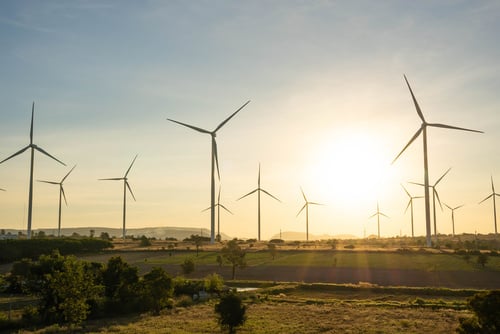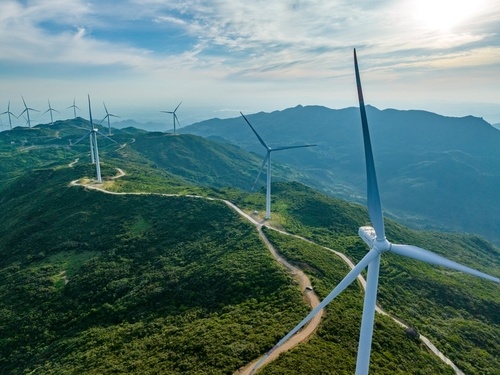Breakdown of the scope 3 categories
27 November 2023
Scope 3 emissions and their significance
When measuring corporate sustainability, a company will often focus only on its direct emissions (Scope 1) and indirect emissions from purchased energy (Scope 2). However, these categories only account for a portion of a company's total GHG footprint.
Scope 3 emissions, encompassing all indirect emissions not included in Scopes 1 and 2, often make up a significant portion of a company's carbon footprint - in some cases as much as 90%. These emissions can arise from various activities, including:
- Business travel
- Waste disposal
- Employee commuting
- Transportation of purchased goods
- Leased assets
Recognizing the importance of Scope 3 emissions, the Greenhouse Gas Protocol (GHG Protocol) developed a standardized framework for classifying and reporting these emissions into 15 categories. We have taken a look at each individual category
Category 1: Purchased goods and services
Purchased goods and services represent an often overlooked yet significant source of indirect greenhouse gas (GHG) emissions for companies. These emissions arise from the production, transportation, and disposal of goods and services that a company purchases.
To effectively reduce emissions from purchased goods and services your organisation can implement the following strategies:
- Collaborate with suppliers to reduce GHG emissions across the supply chain, such as setting emission reduction targets, providing incentives for sustainable practices and sharing best practices.
- Prioritise the purchase of products with lower carbon footprints is a viable option.
- Extending product lifecycles by designing products for durability and longevity, reducing the need for frequent replacements.
- Streamlining logistics and transportation operations will reduce fuel consumption and emissions. This can be done through route optimisation, modal shifts, and the use of energy-efficient vehicles.
Category 2: Capital goods
Machinery, equipment, and vehicles are often essential for business operations, but their associated emissions can make up a substantial portion of a company's carbon footprint.
Quantifying scope 3 emissions from capital goods is difficult due to the complexity of supply chains and the lack of standardised emission factors. For example, secondary emission factors are often relied on but don’t accurately reflect associated emissions for assets.
Despite the challenges, the following strategies can help minimise scope 3 emissions from capital goods investments:- Prioritising energy-efficient assets by investing in capital goods with high energy-efficiency ratings, reducing their operational emissions.
- Proper maintenance can prolong the lifespan of capital goods, minimising the need for replacements
- Implementing responsible disposal or recycling practices for capital goods reduces their environmental impact.
- Collaborate with manufacturers to set emission reduction targets and promote sustainable practices across the supply chain.
Category 3: Fuel and energy
Category 3 encompasses the emissions arising from activities related to fuel and energy that are not already addressed in scopes 1 and 2. This category comprises four subcategories, namely the emissions generated in the production of purchased fuels, the emissions associated with the acquisition of electricity, the losses incurred during transmission and distribution, and the emissions produced from the generation of purchased electricity sold to end users.
Category 4: Upstream transportation and distribution
The transportation of goods and materials along the supply chain, prior to a company's direct involvement have associated emissions. These emissions arise from various transportation modes, including road, rail, air, and sea freight.
Emissions from upstream transportation can be challenging to measure because of the involvement of multiple transportation providers and the lack of standardised emission factors for different transportation modes. The following strategies can mitigate these emissions:
- Work with suppliers to optimise transportation routes, consolidate shipments and choose more energy-efficient transportation modes.
- Incentivising suppliers to shift from high-emitting transportation modes, such as air freight, to lower-emitting alternatives, such as rail or sea freight.
- Partner with transportation providers that prioritise fuel efficiency, adopt renewable energy sources, and implement emission reduction strategies.
- Encourage transparency and data sharing among supply chain partners to better understand emissions related to transportation activities.
Category 5: Waste generated in operations
Refers to emissions associated with the generation, treatment, and disposal of waste materials from a company's operations. These emissions arise from various sources, including:
- Organic waste decomposition
- Incineration of waste
- Transportation of waste
A comprehensive waste management strategy emphasises waste reduction, reuse, and recycling and can significantly reduce the amount of waste sent to landfills and incineration facilities.
Examples of effective waste management practices include:
- Waste audits to identify waste streams and potential reduction opportunities.
- Waste reduction initiatives such as minimising packaging, using reusable materials, and promoting product durability.
- Segregating waste streams and establishing recycling programs to divert materials from landfills.
- Composting organic waste to reduce methane emissions and produce nutrient-rich soil amendment.
- Explore alternative waste treatment options such as waste-to-energy facilities that generate electricity from waste while minimising emissions.
Category 6: Business travel
Emissions associated with employee travel undertaken for work-related purposes, which arise primarily from the use of transportation modes, such as airplanes, trains, rental cars, and taxis.
Quantifying and managing business travel emissions is tricky because of poor standardisation of emission factors for different modes and the difficulty in tracking individual travel patterns.
These challenges can be addressed using the following strategies:
- Encourage the use of virtual meetings and conferences whenever possible to reduce the need for in-person travel.
- Optimising travel itineraries to minimises travel distances and the use of high-emitting transportation modes such as air.
- Encourage employees to choose fuel-efficient vehicles for business travel
- Establish clear travel policies that promote sustainable travel practices, such as setting travel limits, encouraging the use of eco-friendly hotels, and promoting carbon offsetting programs.
Category 7: Employee commuting
These are emissions associated with employees traveling to and from work, primarily from the use of transportation modes, such as cars, motorcycles, public transportation, and bicycles.
Measuring and influencing employee commuting patterns is challenging due to the privacy concerns with tracking employee travel data and attempting to steer employee commuting choices. Additionally, employee commuting decisions are often influenced by personal preferences, public transportation availability, and urban planning factors.
Despite these challenges, ways to encourage sustainable transportation options include:
- Promote flexible work arrangements, such as telecommuting, compressed workweeks, and working from home to reduce the need for daily commuting.
- Create commuting subsidies to provide financial incentives for employees to use public transportation, carpool, or bike to work.
- Enhancing on-site amenities such as bike parking, showers, and lockers, to encourage employees to choose active commuting options.
- Partnering with transportation providers to offer discounted fares or special services for employees.
Category 8: Upstream leased assets
Refers to emissions related to producing and transporting leased assets, such as vehicles, equipment, and buildings, before they are leased by a company. These emissions arise from various activities, including:
- Manufacturing and processing of raw materials
- Assembly and manufacturing of leased assets
- Transportation of leased assets to the lessee
Attributing Scope 3 emissions to leased assets can be challenging due to the lack of visibility into the upstream supply chain and the difficulty in obtaining accurate emission data from manufacturers and suppliers. Additionally, the allocation of emissions between the lessor and lessee can be complex.
These emissions can be reduced by:
- Including sustainability requirements in lease contracts such as specifying minimum energy efficiency standards or requiring suppliers to provide emission data.
- Collaborating with lessors on emission reduction initiatives such as promoting the use of renewable energy sources in manufacturing facilities or adopting fuel-efficient transportation modes for asset delivery.
- Encourage suppliers to adopt emission reduction targets, implement energy efficiency measures, and disclose their environmental performance.
- Establish a system for monitoring and reporting emissions from leased assets, including tracking fuel consumption, energy usage, and waste generation associated with leased assets.
Category 9: Downstream transportation and distribution
Refers to emissions associated with the transportation of products from a company's premises to the end consumer. The various activities include:
- Transportation of products to retailers or distributors
- Delivery of products to end consumers
- Return of products for disposal or recycling
While measuring and influencing downstream emissions from transportation is a challenge because of multiple logistics providers, an organisation can reduce these emissions by:
- Partnering with providers that prioritise fuel efficiency, adopt renewable energy sources, and implement emission reduction strategies.
- Collaborating to optimise transportation routes, consolidate shipments and minimise empty backhauls to reduce fuel consumption and emissions.
- Encourage the use of lower-emitting transportation modes, such as rail or sea freight as well as electric vehicles or biofuels.
- Utilising advanced logistics technologies such as route optimisation software and telematics systems to improve transportation efficiency and reduce emissions.
- Transparency and data sharing amongst supply chain partners to better understand and manage scope 3 emissions from downstream transportation.
Category 10: Processing of sold products
These are emissions associated with the processing, modification, or treatment of products sold by a company after they leave the company's premises, including:
- Manufacturing of components or subassemblies
- Refining or treating raw materials
- Testing and quality control processes
These emissions suffer from the lack of visibility into the downstream supply chain, the involvement of multiple processing partners and the difficulty in obtaining accurate emission data from processors. They can be lowered by:
- Establishing open communication channels and collaborative relationships to discuss reduction goals and identify opportunities for improvement.
- Sharing emission data and providing technical assistance to help partners understand their emissions profile and implement emission reduction measures.
- Incorporating sustainability requirements into supply agreements. This could include specifying minimum energy efficiency standards for processing facilities or requiring suppliers to adopt emission reduction targets.
- introducing programs to reward downstream partners who adopt sustainable practices.
Category 11: Use of sold products
This refers to emissions associated with the energy consumption, operation, and maintenance of products sold by a company during their lifecycle in the hands of end-users. including:
- Energy consumption during product use
- Emissions from product operation and maintenance
The vast number of products in circulation, the diversity of consumer behaviour, and difficulties with tracking individual product usage patterns make these complex to track. You can lower these by:
- Prioritising the design of energy-efficient products that consume less energy during operation
- Integrating renewable energy sources into product design, such as solar panels or rechargeable batteries.
- Design products for durability and longevity to reduce the need for frequent replacements.
- Providing clear and comprehensive instructions that promote efficient operation of products
- Educating consumers by providing tips on how to reduce emissions through sustainable practices.
Category 12: End-of-life treatment of sold products
These emissions arise from various practices, including:
- End of life disposal and treatment.
- Landfilling of products releases methane, a potent greenhouse gas, as organic waste decomposes anaerobically.
- Incinerating products generates GHG emissions from the combustion of materials and the release of harmful pollutants.
- The transportation of waste materials to disposal facilities also contributes to GHG emissions.
Quantifying Scope 3 emissions from end-of-life treatment of products is challenging because of limited visibility into downstream waste management practices, the diversity of product materials and the difficulty in tracking individual product disposal routes.
To counteract these challenges companies can promote sustainable product end-of-life treatment through the following:
- Design products that facilitate disassembly and separation of materials to enhance recyclability and reduce waste generation.
- Use materials that are easily recyclable or compostable to reduce the environmental impact of product disposal.
- Implement take-back programs to collect and manage the end-of-life treatment of sold products.
- Collaborate with reputable waste management companies that prioritize sustainable practices.
- Make consumers aware of the different disposal methods and encourage responsible disposal practices through clear labelling and recycling guides.
- Providing convenient and environmentally friendly options to minimise emissions from end-of-life treatment.
Category 13: Downstream leased assets
These are the emissions associated with operating leased assets after they have been transferred to lessees, including:
- Energy consumption during asset operation
- Emissions from asset maintenance and repairs
The lack of control over the lessee's operations, difficulty in obtaining the correct data from lessees and the complexity of allocating emissions between the lessor and lessee are obstacles to tracking these emissions. Doing the following will help your organisation log them accurately:
- Include sustainability requirements in lease agreements, such as specifying minimum energy efficiency standards for leased assets or requiring lessees to adopt emission reduction measures.
- Providing energy audits and optimisation recommendations to help lessees identify opportunities for reducing energy consumption and associated emissions in leased assets.
- Support and promote lessees to adopt practices, such as using energy-efficient appliances and equipment.
- Establish open communication channels and encourage data sharing with lessees.
Category 14: Franchises
Refers to the emissions associated with the operations of franchised businesses that operate under the franchisor's brand and business model, including:
- Energy consumption: Franchises often consume significant amounts of energy for lighting, heating, cooling, and operating equipment.
- Waste generation and disposal: Franchises may generate large quantities of waste from packaging, food scraps, or other materials.
- Transportation: Franchises often rely on vehicles for deliveries, customer transport, or product distribution.
The decentralised nature of franchise businesses, diversity of franchise activities and the difficulties in obtaining accurate data from individual franchisees make this particularly difficult. Franchisors may also have limited control over the operational decisions of franchisees.
Ways of combatting this include:
- Developing clear sustainability guidelines and setting emission reduction targets for franchisees, providing a framework for improvement.
- Offer franchisees training on sustainable practices, energy efficiency measures, and waste reduction strategies.
- Centralised reporting systems will help to collect and analyse emission data from franchisees, enabling improved tracking and identifying areas for improvement.
- Offering incentives and rewards to franchisees that demonstrate leadership in sustainability and achieve emission reduction goals.
- Encourage franchisees to adopt sustainable procurement practices, such as sourcing eco-friendly products and working with sustainable suppliers.
- actively involve franchisees in sustainability initiatives, fostering collaboration and a shared commitment to environmental responsibility.
Category 15: Investments
These are the greenhouse gas (GHG) emissions associated with investments in other companies or entities, such as subsidiaries, joint ventures, or associate companies.
There is often a lack of direct control over the investee companies' operations and difficulty in obtaining accurate emission data. However, investors can adopt several strategies to manage this category of scope 3 emissions including:
- Establishing open communication channels with investee companies to discuss sustainability goals, emission reduction targets, and opportunities for improvement.
- Integrating sustainability criteria into investment decisions by incorporating environmental, social, and governance (ESG) factors.
- Offer incentives, such as preferential financing or performance-based rewards, to investee companies that demonstrate progress towards sustainability goals
- Promote transparency and data sharing among investee companies to better understand their environmental impact and identify collaborative emission reduction initiatives.
Latest news
ESOS: Why the Environmental Agency penalises businesses
This blog explores some of the reasons why companies fall short and provide practical advice on how to avoid these pitfalls.
ESOS Action Plans: What do they include?
Starting from the third compliance period, the Energy Savings Opportunities Scheme (ESOS) introduced additional reporting requirements. After submitting your compliance notification, you must produce...
6 Key Energy Trends to Watch in 2025
The energy world is changing fast, and 2025 is shaping up to be another big year. Whether you’re a business leader, investor, or just someone keeping an eye on where the industry is headed, staying...
See how much we could save you
Please call our team on 0345 634 9500 or email us at info@tridentutilities.co.uk.






